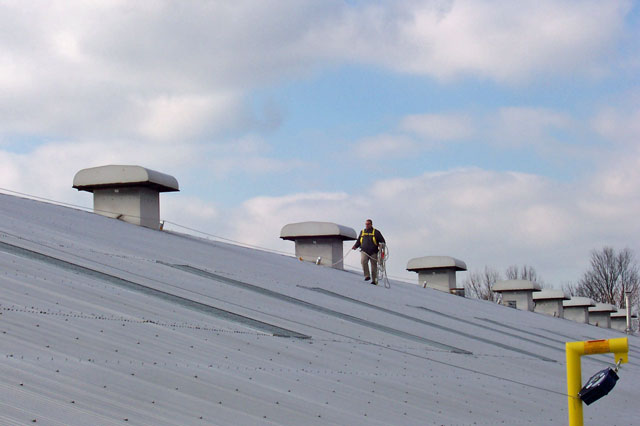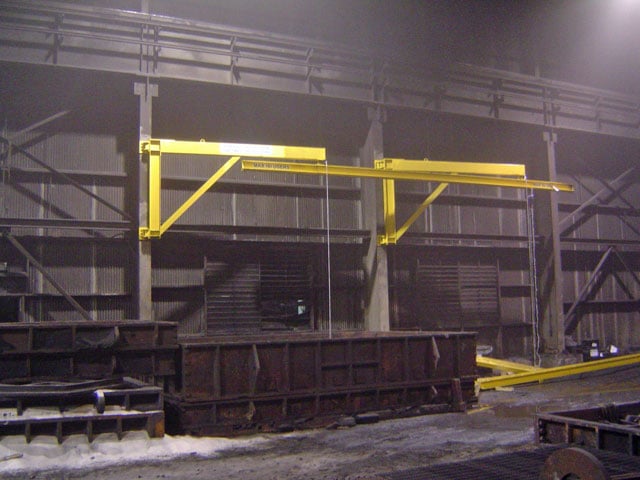Fall Protection & Fall Arrest Systems for the Steel Industry
Steel mill ladle cranes moving and pouring molten material are subjected to harsh working environments, with a high number of daily cycles, intense heat, and dirt all taking a toll on even the most durable equipment. Economic considerations and safety imperatives require frequent crane inspection and preventative maintenance, which is often performed at heights, exposing your personnel to significant fall hazards that may result in serious injury or death. Ensuring worker safety and OSHA compliance requires the implementation of a comprehensive fall prevention strategy, which includes the proper mix of fall protection equipment, personnel training, and partnering with a fall protection company that appreciates the unique nature of your steel mill’s access points and potential fall hazards.

Stell Mill Fall Protection

Stell Mill Fall Protection

Stell Mill Fall Protection
We are a complete turnkey provider of steel mill fall protection systems and have years of design and installation experience in these market sectors. Contact us for expert assistance with your fall arrest, fall restraint and fall protection requirements.
Fall Protection Solutions
-
Catwalks
-
Confined Space & Rescue
View Confined Space & Rescue -
Horizontal Lifelines
View Horizontal Lifelines -
Crane Rail Lifelines
View Crane Rail Lifelines -
Overhead Horizontal Lifelines
View Overhead Horizontal Lifelines -
Loading Platforms, Stairs & Gangways
View Loading Platforms, Stairs & Gangways -
Rigid Rail Fall Protection Systems
View Rigid Rail Fall Protection Systems -
Articulating Jib & Trolley Systems
View Articulating Jib & Trolley Systems -
Cartesian Bridge Systems
View Cartesian Bridge Systems -
Trolley Beam Fall Arrest
View Trolley Beam Fall Arrest -
Fall Protection Anchors
View Fall Protection Anchors
Design Considerations
Steel Mill Fall Protection Design Considerations
Extensive use of overhead cranes in foundry applicaions presents a number of fall protection challenges. Precise placement of horizontal lifeline systems is required to provide unimpeded crane movement, and access stairs and ladders may be needed to reduce the risks associated with climbing up to a monorail or overhead crane.
Fall protection is required below cranes as well. Working at height in crane bays presents problems when the fall protection system interferes with the movement of an overhead crane. Crane bays often require a fold-away or articulating fall protection system that can be deployed as needed and retracted when overhead cranes are in use. Jib beam fall protection systems are ideal in any situation where permanently installed systems might interfere with the operation of overhead equipment. Regardless of your overhead crane’s unique path through the plant, or the foot-print of other equipment and obstructions, engineered, fold-away fall arrest systems offer a perfect blend of OSHA compliance and maximum productivity.
OSHA Regulations
- HLL/VLL
- 1926.502(d)
'Personal fall arrest systems.' Personal fall arrest systems and their use shall comply with the provisions set forth below. Effective January 1, 1998, body belts are not acceptable as part of a personal fall arrest system. Note: The use of a body belt in a positioning device system is acceptable and is regulated under paragraph (e) of this section. - 1926.502(d)(8)
Horizontal lifelines shall be designed, installed, and used, under the supervision of a qualified person, as part of a complete personal fall arrest system, which maintains a safety factor of at least two. - 1926.502(d)(9)
Lanyards and vertical lifelines shall have a minimum breaking strength of 5,000 pounds (22.2 kN). - 1926.502(d)(10) 1926.502(d)(10)(i)
Except as provided in paragraph (d)(10)(ii) of this section, when vertical lifelines are used, each employee shall be attached to a separate lifeline. - 1926.502(d)(11)
Lifelines shall be protected against being cut or abraded. - 1926.502(d)(12)
Self-retracting lifelines and lanyards which automatically limit free fall distance to 2 feet (0.61 m) or less shall be capable of sustaining a minimum tensile load of 3,000 pounds (13.3 kN) applied to the device with the lifeline or lanyard in the fully extended position. - 1926.502(d)(13)
Self-retracting lifelines and lanyards which do not limit free fall distance to 2 feet (0.61 m) or less, ripstitch lanyards, and tearing and deforming lanyards shall be capable of sustaining a minimum tensile load of 5,000 pounds (22.2 kN) applied to the device with the lifeline or lanyard in the fully extended position.
- 1926.502(d)
- Personal Fall Arrest Systems
- 1926.502(d)
'Personal fall arrest systems.' Personal fall arrest systems and their use shall comply with the provisions set forth below. Effective January 1, 1998, body belts are not acceptable as part of a personal fall arrest system. Note: The use of a body belt in a positioning device system is acceptable and is regulated under paragraph (e) of this section. - 1926.502(d)(16)
Personal fall arrest systems, when stopping a fall, shall: - 1926.502(d)(16)(i)
limit maximum arresting force on an employee to 900 pounds (4 kN) when used with a body belt; - 1926.502(d)(16)(ii)
limit maximum arresting force on an employee to 1,800 pounds (8 kN) when used with a body harness; - 1926.502(d)(16)(iii)
be rigged such that an employee can neither free fall more than 6 feet (1.8 m), nor contact any lower level; - 1926.502(d)(16)(iv)
bring an employee to a complete stop and limit maximum deceleration distance an employee travels to 3.5 feet (1.07 m); and, - 1926.502(d)(16)(v)
have sufficient strength to withstand twice the potential impact energy of an employee free falling a distance of 6 feet (1.8 m), or the free fall distance permitted by the system, whichever is less.
- 1926.502(d)
- Ladders
- 1926.1053(a)(18)
Fixed ladders shall be provided with cages, wells, ladder safety devices, or self-retracting lifelines where the length of climb is less than 24 feet (7.3 m) but the top of the ladder is at a distance greater than 24 feet (7.3 m) above lower levels. - 1926.1053(a)(19)
Where the total length of a climb equals or exceeds 24 feet (7.3 m), fixed ladders shall be equipped with one of the following: - 1926.1053(a)(19)(i)
Ladder safety devices; or - 1926.1053(a)(19)(ii)
Self-retracting lifelines, and rest platforms at intervals not to exceed 150 feet (45.7 m); or - 1926.1053(a)(19)(iii)
A cage or well, and multiple ladder sections, each ladder section not to exceed 50 feet (15.2 m) in length. Ladder sections shall be offset from adjacent sections, and landing platforms shall be provided at maximum intervals of 50 feet (15.2 m). - 1926.1053(a)(20)
- 1926.1053(a)(18)
Talk to a fall protection specialist
Tell us about your fall protection needs, and we’ll configure a system that rises to your challenges.
Talk to a fall protection specialist
Tell us about your fall protection needs, and we’ll configure a system that rises to your challenges.

